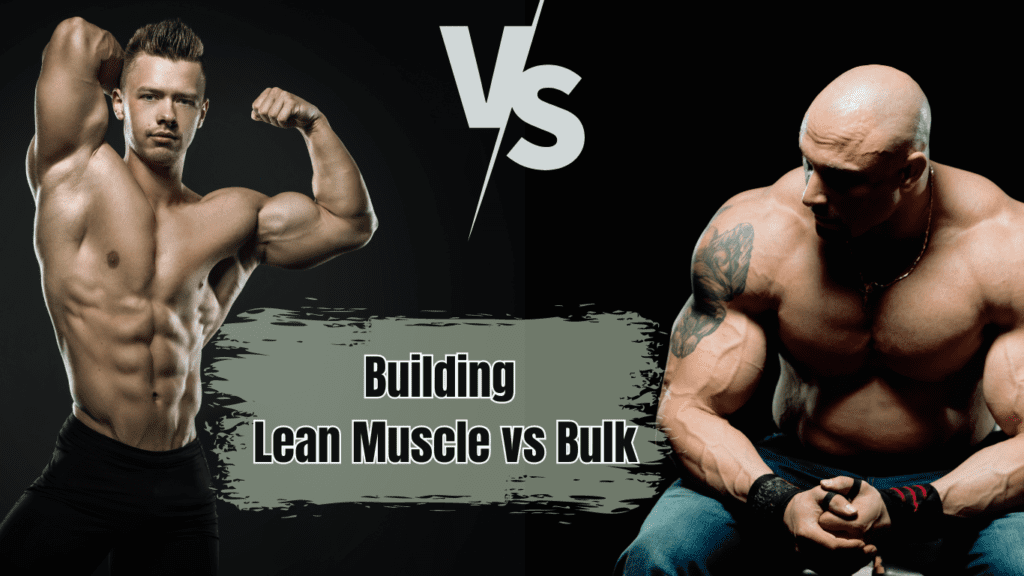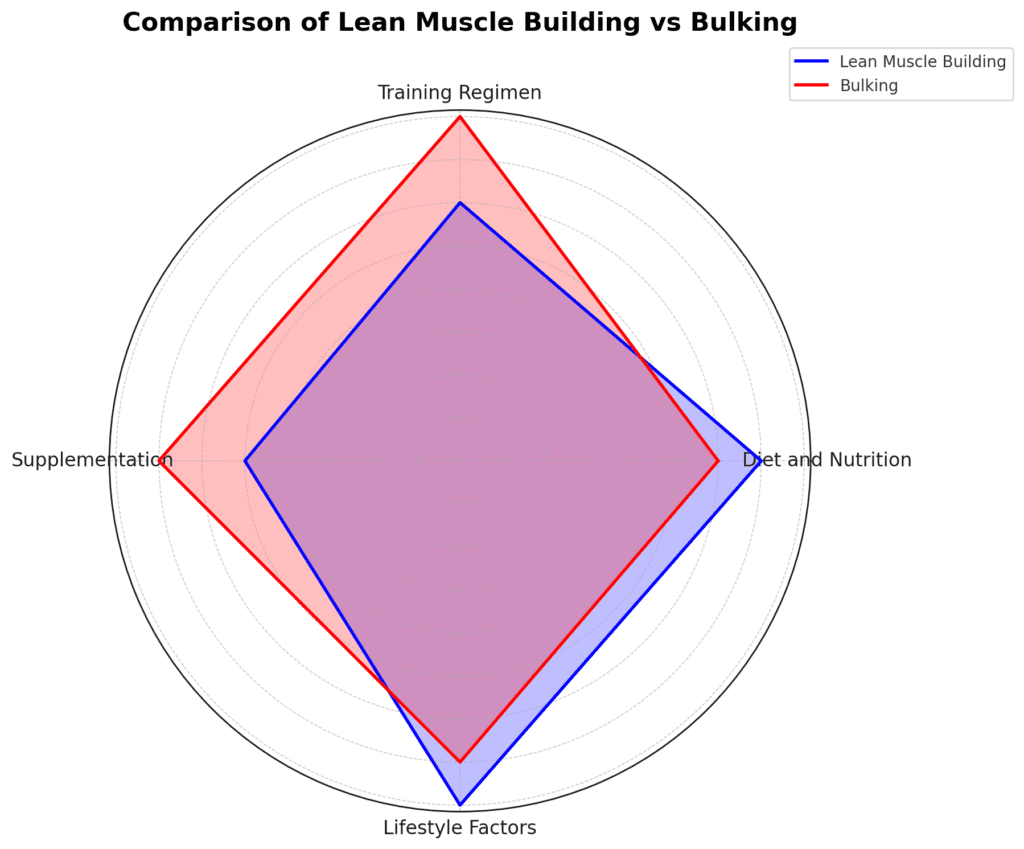Introduction to Building Lean Muscle vs Bulk: Understanding the Basics
Are you striving for a chiseled, lean physique or aiming to pack on serious muscle mass? Understanding the nuances between building lean muscle vs bulk can dramatically impact your fitness journey and end results.
Embarking on a fitness journey can be both exciting and overwhelming, especially when faced with decisions that shape your workout routines and dietary choices. This article delves into the fundamental differences between building lean muscle vs bulk, shedding light on the strategies, benefits, and potential pitfalls of each approach. By the end, you’ll have a clearer perspective on which path aligns with your personal fitness goals.

To begin with, let’s clarify the core difference between building lean muscle vs bulk. Building lean muscle focuses on increasing muscle mass while maintaining a low body fat percentage, resulting in a toned and defined appearance. On the other hand, bulking aims at maximizing muscle gain, which often includes an increase in overall body weight, including some fat gain.
Understanding these differences is crucial for several reasons. It influences your workout routine, nutrition plan, and lifestyle choices. Knowing whether you want to lean out or bulk up will guide your decisions in the gym and at the dining table.
When it comes to workouts, those focusing on building lean muscle often incorporate higher repetitions with moderate weights. This approach emphasizes muscle endurance and definition. Typically, these routines include a mix of resistance training and cardiovascular exercises to help burn fat while sculpting muscle. Rest periods between sets are usually shorter, around 30-60 seconds, to keep the heart rate elevated and promote calorie burning.
Conversely, if your goal is to bulk, the emphasis shifts to lifting heavier weights with fewer repetitions. This method stimulates muscle hypertrophy, leading to significant muscle growth. Workouts for bulking often involve compound movements like squats, deadlifts, and bench presses, which target multiple muscle groups simultaneously. Rest periods are longer, around 1-2 minutes, to allow for full recovery between sets, enabling maximum lifting capacity.
Nutrition plays a pivotal role in distinguishing building lean muscle vs bulk. For lean muscle, a balanced diet with a slight caloric surplus is ideal. This means consuming just enough extra calories to support muscle growth without accumulating excess fat. The focus is on high-quality protein, complex carbohydrates, and healthy fats. Lean proteins like chicken, fish, and tofu, along with whole grains, vegetables, and nuts, form the cornerstone of this diet.
Bulking, however, requires a more substantial caloric surplus to fuel intense workouts and support muscle recovery. This often means consuming more calories than you burn daily. While protein remains essential, the intake of carbohydrates and fats increases significantly. Foods like red meat, dairy products, and starchy vegetables become staples. However, it’s important to approach bulking with a healthy mindset, avoiding excessive junk food that can lead to unhealthy fat gain.
Subscribe And Get Our Free E-Book:Unlocking The Power Of Nutrition-Supplements, Substitutes, and Superfoods!
Recovery and rest are also critical components of both approaches. For those building lean muscle, sufficient sleep and active recovery days are important to repair and grow muscles. Incorporating activities like yoga or light stretching can aid recovery while maintaining flexibility.
For bulking, the demand for recovery is even higher due to the intensity of the workouts. Ensuring ample sleep, perhaps 8-9 hours a night, and incorporating rest days into the weekly routine are crucial for muscle growth and overall recovery.
Both paths have their unique benefits and challenges. Building lean muscle enhances muscle definition, boosts metabolic rate, and contributes to overall cardiovascular health. It’s often seen as a sustainable long-term approach to fitness. However, it can be challenging to gain significant muscle mass without gaining fat, requiring precise dietary control and consistent workouts.
Bulking, on the other hand, allows for substantial muscle gains and strength improvements. It’s particularly beneficial for athletes and individuals looking to dramatically increase their muscle mass. Yet, the downside is the inevitable fat gain that accompanies the process, necessitating a subsequent cutting phase to shed the excess fat and reveal the muscle underneath.
Ultimately, the choice between building lean muscle vs bulk depends on your personal goals, body type, and lifestyle preferences. If a sculpted, defined look is your aim, focusing on lean muscle may be the best approach. For those aiming to gain significant muscle mass and strength, bulking might be the preferred path.
Whichever route you choose, understanding the fundamental principles of building lean muscle vs bulk is essential. Both approaches require dedication, consistency, and a well-rounded strategy encompassing exercise, nutrition, and recovery. By tailoring your plan to align with your goals, you can make informed decisions that drive you closer to achieving the physique you desire.
Whether you decide to lean out or bulk up, the journey is personal and unique. Embrace the process, stay committed, and remember that every step taken towards your goal is a step towards a healthier, stronger you.
Building Lean Muscle vs Bulk: Understanding Muscle Building
Understanding the difference between building lean muscle vs bulk is essential for anyone serious about fitness. These two approaches not only shape your physique differently but also have unique goals and physiological impacts. Let’s dive into what each method entails and the science behind them.
Lean muscle building is all about increasing muscle mass while maintaining a low body fat percentage. The result is a defined, toned appearance with visible muscle striations. This approach emphasizes a balanced, sustainable growth of muscle without significant fat gain. The goal is often aesthetics – achieving a fit, athletic look that is not overly bulky. Additionally, lean muscle building improves overall strength and endurance, contributing to better athletic performance and daily functional fitness.

Bulking, on the other hand, focuses on maximizing muscle gain, often accepting an increase in body fat as part of the process. The primary aim is to build as much muscle mass as possible in a relatively short period. This method is popular among bodybuilders and athletes who need significant muscle size and strength for their sports. While the bulked-up look is less defined due to higher body fat, it can lead to substantial gains in raw strength and power.

When discussing building lean muscle vs bulk, it’s crucial to understand the specific goals of each approach. For lean muscle building, the goals are usually:
- Aesthetic appeal: Achieving a sculpted, athletic physique with clear muscle definition.
- Functional strength: Enhancing strength without excessive bulk, improving overall fitness and agility.
- Sustainable health: Maintaining a balanced body composition with a focus on long-term health and fitness.
In contrast, the goals for bulking often include:
- Maximum muscle mass: Achieving significant gains in muscle size, often at the expense of a higher body fat percentage.
- Strength enhancement: Building raw power and strength, essential for sports that require explosive movements.
- Performance improvement: Enhancing performance in specific sports or bodybuilding competitions where size and strength are critical.
The physiological differences between building lean muscle vs bulk are also noteworthy. When you focus on lean muscle building, your body undergoes processes that prioritize muscle definition and endurance. Muscle hypertrophy, the increase in muscle size, occurs through two main types: sarcoplasmic and myofibrillar hypertrophy.
Sarcoplasmic hypertrophy involves an increase in the volume of the sarcoplasmic fluid in the muscle cell, which enhances muscle endurance and gives a fuller look to the muscles. This type of hypertrophy is typically achieved through higher repetition ranges and shorter rest periods. It’s common in lean muscle building routines where the goal is to develop endurance and muscle definition without adding excessive mass.
Myofibrillar hypertrophy involves an increase in the size and number of the muscle fibers themselves, leading to greater strength and muscle density. This type of hypertrophy is achieved through lower repetition ranges and heavier weights, with longer rest periods. It’s often the focus in bulking routines where the aim is to increase muscle size and strength significantly.
In the context of building lean muscle vs bulk, lean muscle building often favors sarcoplasmic hypertrophy because it contributes to a more defined and toned appearance. This approach includes a mix of resistance training with moderate weights, higher reps, and cardiovascular exercises to burn fat. The goal is to create a calorie deficit or a slight surplus to build muscle without gaining much fat.
Bulking, however, leans more towards myofibrillar hypertrophy. The training involves heavy lifting with compound movements, such as squats, deadlifts, and bench presses, to stimulate maximum muscle growth. The diet supports a significant caloric surplus to provide the necessary nutrients for muscle repair and growth. This approach often leads to muscle gains accompanied by fat gain, which is later addressed during a cutting phase to reduce fat and reveal the muscle underneath.

Fat storage is another physiological difference in building lean muscle vs bulk. Lean muscle building aims to minimize fat gain by carefully managing calorie intake and emphasizing a clean diet rich in protein, complex carbohydrates, and healthy fats. This method helps maintain a low body fat percentage, making muscle definition more apparent.
Bulking, conversely, accepts some fat gain as part of the muscle-building process. The caloric surplus required for bulking means consuming more calories than the body burns, which inevitably leads to some fat storage. The focus during bulking is on maximizing muscle gain, with the understanding that fat can be shed later during a cutting phase.
The distinction between building lean muscle vs bulk lies in the specific goals and physiological processes involved. Lean muscle building prioritizes muscle definition, endurance, and a balanced body composition, often achieved through higher reps, moderate weights, and a clean diet. Bulking focuses on maximizing muscle mass and strength, utilizing heavy weights, lower reps, and a significant caloric surplus to support muscle growth. Understanding these differences helps tailor your fitness strategy to your personal goals, whether you aim for a lean, toned physique or substantial muscle size and strength.
Comparison Chart: Building Lean Muscle vs. Bulking
| Aspect | Building Lean Muscle | Bulking |
|---|---|---|
| Primary Goal | Achieve a toned and defined physique with minimal fat gain | Maximize muscle mass, accepting some fat gain |
| Training Style | Higher reps with moderate weights, shorter rest periods | Lower reps with heavy weights, longer rest periods |
| Typical Exercises | Combination of resistance training and cardio | Focus on compound movements like squats, deadlifts, and bench presses |
| Caloric Intake | Slight caloric surplus or maintenance | Significant caloric surplus |
| Diet Composition | High protein, moderate carbs, and healthy fats; clean eating focus | High protein, high carbs, increased fats; more caloric density |
| Body Fat Management | Aim to maintain or slightly reduce body fat | Expect some fat gain, managed in a cutting phase later |
| Outcome | Lean, athletic, and defined appearance | Increased muscle mass with bulkier physique |
| Recovery Needs | Emphasis on active recovery and flexibility | High recovery needs due to intense workouts |
| Suitable For | Individuals seeking aesthetics and functional strength | Bodybuilders or athletes aiming for maximum strength and size |
Lean Muscle Building
Understanding the dietary and training principles behind building lean muscle vs bulk is essential for anyone looking to achieve their fitness goals. In this section, we will focus on the diet and nutrition required for lean muscle building, the ideal training regimen, supplementation, and important lifestyle factors.
Diet and Nutrition
When it comes to building lean muscle, diet and nutrition are paramount. The goal is to provide the body with the right nutrients to support muscle growth while minimizing fat gain. This involves a careful balance of macronutrients: protein, carbohydrates, and fats.
Protein is the most critical macronutrient for muscle building. It provides the amino acids necessary for muscle repair and growth. Aim for approximately 1.2 to 2.2 grams of protein per kilogram of body weight. Good sources of protein include lean meats like chicken and turkey, fish, eggs, dairy products, and plant-based options like beans, lentils, and tofu.
Carbohydrates are essential for providing the energy needed for intense workouts. They replenish glycogen stores in muscles, ensuring you have the stamina to perform well during training sessions. Focus on complex carbohydrates such as whole grains, oats, brown rice, quinoa, and sweet potatoes. These provide a steady release of energy and are packed with essential nutrients.
Fats play a role in hormone production and overall health. Include healthy fats from sources like avocados, nuts, seeds, olive oil, and fatty fish. Aim to keep fats to around 20-30% of your total daily calorie intake.
I Don’t Want To Get To Big Video
For lean muscle building, maintaining a calorie deficit or at least maintenance is important to prevent excess fat gain. Calculate your daily caloric needs based on your activity level and ensure you are consuming enough to support muscle growth without creating a significant surplus.
Here’s an example of a meal plan for someone focused on building lean muscle:
- Breakfast: Scrambled eggs with spinach and whole-grain toast.
- Mid-morning snack: Greek yogurt with berries and a handful of nuts.
- Lunch: Grilled chicken breast with quinoa and steamed broccoli.
- Afternoon snack: Apple slices with almond butter.
- Dinner: Baked salmon with sweet potatoes and a side salad.
- Evening snack: Cottage cheese with a sprinkle of chia seeds.
Training Regimen
The training regimen for building lean muscle should include a mix of compound and isolation exercises. Compound exercises, like squats, deadlifts, bench presses, and pull-ups, work multiple muscle groups simultaneously and are essential for building overall muscle mass and strength. Isolation exercises, such as bicep curls and tricep extensions, target specific muscles to enhance definition and symmetry.
Recommended workout frequency is typically 3-5 days per week, allowing for rest days to enable muscle recovery. Each session should focus on different muscle groups to ensure balanced development and avoid overtraining.

Workout volume should be moderate, with 3-4 sets of 8-12 repetitions for each exercise. This range is effective for promoting muscle hypertrophy, especially when combined with progressive overload, which involves gradually increasing the weight or resistance used in exercises to continue challenging the muscles.
Intensity is crucial. Workouts should be challenging enough to push the muscles beyond their comfort zone, stimulating growth and adaptation. Incorporate techniques like drop sets, supersets, and varying rep ranges to keep the muscles guessing and promote continuous progress.
Supplementation
While a well-rounded diet is the foundation for muscle building, certain supplements can enhance the process. Here are some common supplements for building lean muscle:
- Whey protein: A fast-digesting protein source that’s ideal for post-workout recovery, helping to repair and build muscle tissue.
- BCAAs (Branched-Chain Amino Acids): These amino acids (leucine, isoleucine, and valine) support muscle protein synthesis and reduce muscle breakdown during intense workouts.
- Creatine: Increases ATP production, providing extra energy for high-intensity exercise and promoting muscle strength and growth.
Their roles and benefits vary, but when used correctly, these supplements can complement a balanced diet and rigorous training regimen to enhance muscle gains and recovery.
Lifestyle Factors
Sleep and recovery are critical for muscle growth. Aim for 7-9 hours of quality sleep per night to ensure your body has the time it needs to repair and build muscle tissue. Lack of sleep can hinder recovery and reduce performance in the gym.
Stress management is another important factor. High stress levels can increase the hormone cortisol, which can lead to muscle breakdown and hinder recovery. Incorporate stress-reducing activities like meditation, deep breathing exercises, or hobbies that you enjoy.
Staying hydrated is essential for overall health and muscle function. Dehydration can impair muscle recovery and performance. Aim to drink at least 8-10 glasses of water per day, more if you are engaging in intense exercise.
The principles of diet, training, supplementation, and lifestyle factors for building lean muscle vs bulk are distinct and tailored to different fitness goals. For lean muscle building, focus on a balanced macronutrient intake, maintain a slight calorie deficit or maintenance level, and prioritize protein. Implement a training regimen that includes both compound and isolation exercises, with an emphasis on intensity and progressive overload. Supplement wisely to support muscle recovery and growth, and pay attention to sleep, stress management, and hydration. By understanding and applying these principles, you can achieve a lean, defined physique while maintaining overall health and fitness.
Bulking
When exploring the topic of building lean muscle vs bulk, it’s essential to understand the distinct dietary and training principles associated with bulking. This approach emphasizes maximizing muscle growth, often accompanied by some fat gain. Let’s delve into the specifics of diet and nutrition, training regimens, supplementation, and crucial lifestyle factors for an effective bulking phase.
Diet and Nutrition
In bulking, the primary goal is to create a calorie surplus. This means consuming more calories than your body burns in a day to support intense training and muscle growth. A well-structured macronutrient breakdown is crucial to ensure that the extra calories contribute to muscle mass rather than excess fat.
Protein intake remains vital for muscle repair and growth. Aim for 1.6 to 2.2 grams of protein per kilogram of body weight. High-quality protein sources include lean meats, fish, eggs, dairy products, and plant-based options like beans and legumes.
Carbohydrates are the main energy source during a bulking phase. They help replenish glycogen stores, providing the energy needed for heavy lifting. Focus on complex carbohydrates such as whole grains, oats, rice, potatoes, and fruits. These provide sustained energy and essential nutrients.
Fats should also be included in a bulking diet to support hormone production and overall health. Healthy fats from sources like avocados, nuts, seeds, and olive oil are beneficial. Fats should make up about 20-30% of your total caloric intake.
An example meal plan for someone focused on bulking might include:
- Breakfast: Oatmeal with a scoop of protein powder, topped with banana slices and peanut butter.
- Mid-morning snack: Greek yogurt with honey and a handful of almonds.
- Lunch: Grilled chicken breast with brown rice and steamed vegetables.
- Afternoon snack: A protein shake with a piece of fruit.
- Dinner: Steak with sweet potatoes and a side salad.
- Evening snack: Cottage cheese with mixed berries.

Training Regimen
Bulking requires a specific approach to training, focusing on heavy lifting and compound movements. These exercises engage multiple muscle groups and are effective for building overall mass and strength.
Key compound exercises include squats, deadlifts, bench presses, and overhead presses. These should form the foundation of your workout routine.
Recommended workout frequency is typically 4-6 days per week, allowing for sufficient rest and recovery between sessions. Each workout should focus on different muscle groups, ensuring balanced development and avoiding overtraining.
Workout volume should be high, with 3-5 sets of 6-12 repetitions for each exercise. This range is optimal for muscle hypertrophy. Emphasize lifting heavy weights to stimulate muscle growth. Progressive overload, the gradual increase of weight or resistance, is essential for continuous progress.
Incorporate muscle confusion techniques, such as changing the order of exercises, varying rep ranges, and integrating different training methods like drop sets and supersets. This keeps the muscles challenged and prevents plateaus.
Supplementation
Supplements can enhance the effectiveness of a bulking diet and training regimen. Here are some common supplements for bulking:
- Mass gainers: These provide a high-calorie mix of protein, carbohydrates, and fats, helping you achieve a calorie surplus. They are particularly useful for those who struggle to consume enough calories through food alone.
- Creatine: This supplement increases ATP production, providing more energy for high-intensity workouts and supporting muscle strength and growth.
Their roles and benefits vary, but when used correctly, supplements can complement a balanced diet and rigorous training regimen, enhancing muscle gains and recovery.
Lifestyle Factors
Sleep and recovery are crucial during the bulking phase. Aim for 7-9 hours of quality sleep per night to ensure your body has time to repair and build muscle tissue. Adequate rest also supports optimal hormone production, including growth hormone and testosterone, which are essential for muscle growth.
Managing fat gain is an important consideration when bulking. While some fat gain is inevitable, it can be minimized by carefully monitoring calorie intake and adjusting as needed. Regularly track your body composition and make dietary adjustments to ensure you are gaining muscle without excessive fat.
Staying hydrated is essential for overall health and muscle function. Dehydration can impair muscle recovery and performance. Aim to drink at least 8-10 glasses of water per day, more if you are engaging in intense exercise.
Understanding the principles of diet, training, supplementation, and lifestyle factors for building lean muscle vs bulk is essential for achieving your fitness goals. For bulking, focus on creating a calorie surplus with a balanced macronutrient intake, prioritize heavy lifting and compound movements in your training regimen, and use supplements strategically to support muscle growth and recovery. Pay attention to sleep, manage fat gain, and stay hydrated to ensure overall health and optimal muscle development. By applying these principles, you can effectively build muscle mass and strength, progressing towards a stronger, more powerful physique.
Comparing Building Lean Muscle vs Bulk: Pros and Cons
When comparing building lean muscle vs bulk, it’s important to weigh the pros and cons of each approach. Both methods have distinct advantages and challenges, and understanding these can help you choose the best path for your fitness goals.

Lean Muscle Building
Benefits
One of the primary benefits of lean muscle building is achieving a defined and toned physique. This approach focuses on increasing muscle mass while maintaining a low body fat percentage, resulting in a sculpted, athletic look. Visible muscle definition not only enhances physical appearance but also boosts confidence and self-esteem.
Another significant advantage is lower fat levels. By carefully managing caloric intake and emphasizing clean eating, lean muscle building helps maintain a healthy body composition. This not only contributes to a more aesthetic appearance but also supports overall health, reducing the risk of lifestyle-related diseases such as obesity, diabetes, and cardiovascular conditions.
Functional strength and endurance are also key benefits. Lean muscle building incorporates a balanced mix of resistance training and cardiovascular exercises, enhancing both muscular strength and aerobic capacity. This improves overall fitness, making daily activities easier and enhancing athletic performance.
Challenges
However, lean muscle building comes with its challenges. One of the main difficulties is the slower rate of muscle gain. Because this approach involves a controlled caloric intake to avoid excess fat gain, muscle growth can be more gradual compared to bulking. Patience and consistency are crucial, as results may take longer to become noticeable.
Maintaining a stricter diet is another challenge. To ensure that muscle is built without gaining significant fat, a clean diet with precise macronutrient ratios is essential. This often means avoiding high-calorie, low-nutrient foods and consistently tracking food intake, which can be demanding and requires a high level of discipline and planning.
Bulking
Benefits
In contrast, bulking offers the benefit of rapid muscle gain. By consuming a caloric surplus, the body is provided with ample nutrients to support quick muscle growth. This approach is particularly effective for individuals looking to increase muscle mass significantly in a shorter period, such as bodybuilders during their off-season.
Another major advantage is the increase in strength. The high-intensity, heavy lifting associated with bulking stimulates significant gains in muscular strength. This not only contributes to a more powerful physique but also enhances performance in activities requiring strength, such as weightlifting, certain sports, and physical labor.
Challenges
Despite its benefits, bulking also presents several challenges. One of the primary drawbacks is the potential for fat gain. Since bulking requires a calorie surplus, it’s inevitable that some of these extra calories will be stored as fat. This can lead to a less defined physique and may require a subsequent cutting phase to reduce body fat and reveal the muscle gains underneath.
The need for a cutting phase is another challenge. After a bulking period, many individuals undertake a cutting phase to shed the excess fat gained. This involves switching to a calorie deficit and often includes increased cardiovascular exercise. The cutting phase can be mentally and physically demanding, requiring a shift in diet and training focus, and can sometimes result in muscle loss if not managed carefully.
Additionally, maintaining a high-calorie intake necessary for bulking can be difficult. Consuming large quantities of food, especially from healthy sources, can be challenging and may require significant effort in meal planning and preparation. It can also be expensive and time-consuming.

Chart Explanation:
The radar chart above illustrates the key differences between lean muscle building and bulking strategies across four main categories: diet, training, supplementation, and lifestyle.
- Diet: Lean muscle building focuses on a moderate caloric surplus with a balanced macronutrient distribution, ensuring that muscle is gained with minimal fat. Bulking, on the other hand, involves a significant caloric surplus, often leading to faster muscle gains but with a higher likelihood of fat accumulation.
- Training: For lean muscle building, training is intense but controlled, emphasizing muscle preservation and gradual strength gains. Bulking encourages a higher training volume with a focus on maximizing muscle hypertrophy, sometimes at the expense of strict form or recovery.
- Supplementation: Lean muscle building includes a targeted supplementation strategy, often with a focus on protein, BCAAs, and lean mass gainers. Bulking might involve more aggressive supplementation, including mass gainers and higher doses of creatine or other anabolic aids.
- Lifestyle: Lean muscle building requires strict adherence to sleep, recovery, and stress management, as the goal is to optimize muscle gain without excess fat. Bulking allows for more flexibility in lifestyle choices, with a greater focus on calorie intake than on maintaining a strict regimen.
The decision between building lean muscle vs bulk should be based on your individual goals, preferences, and lifestyle. Lean muscle building is ideal for those seeking a defined, toned physique, improved overall health, and functional strength, despite the slower muscle gain and stricter diet requirements. Bulking, on the other hand, is suited for those aiming for rapid muscle growth and increased strength, though it comes with the challenges of potential fat gain and the need for a cutting phase. Understanding these pros and cons allows you to make an informed decision and align your fitness strategy with your personal objectives.
Common Myths and Misconceptions
Understanding the reality of building lean muscle vs bulk involves debunking several common myths and misconceptions. Misguided beliefs can hinder progress and lead to ineffective or unhealthy practices. In this section, we will clarify some of the most prevalent myths about lean muscle building and bulking, providing accurate information to guide your fitness journey.
Lean Muscle Building Myths
One pervasive myth is that “You can’t build muscle in a calorie deficit.” While it’s true that a calorie surplus can enhance muscle growth, building lean muscle while in a slight calorie deficit is possible, especially for beginners, those returning to training after a break, or individuals with higher body fat percentages. This process, known as “recomping,” involves carefully balancing protein intake and resistance training to stimulate muscle growth while losing fat.
Another common misconception is that “High reps for tone, low reps for bulk.” This myth suggests that performing high repetitions with lighter weights will create a toned appearance, while low repetitions with heavier weights will lead to bulky muscles. In reality, muscle growth (hypertrophy) is influenced by various factors, including the total volume of training, intensity, and progressive overload. Both high and low rep ranges can be effective for building lean muscle, depending on the overall training program and individual goals.
A third myth is “Women will get bulky if they lift heavy weights.” This misconception often discourages women from engaging in strength training. In truth, women typically have lower testosterone levels than men, making it difficult to gain large amounts of muscle mass. Heavy lifting helps build lean muscle and strength, contributing to a toned and athletic appearance rather than bulkiness.
Lastly, the idea that “You need to eat constantly to build muscle” is misleading. While regular meals help maintain energy levels and support muscle repair, the quality of food and overall caloric and macronutrient intake are more important than eating frequency. Three balanced meals and snacks tailored to individual energy needs can be just as effective as multiple small meals throughout the day.
Bulking Myths
A prevalent myth in bulking is that “You must eat junk food to bulk.” While consuming a calorie surplus is necessary for bulking, the source of these calories is crucial. Eating large amounts of unhealthy, processed foods can lead to excessive fat gain and poor health outcomes. Instead, focus on nutrient-dense, whole foods like lean proteins, complex carbohydrates, and healthy fats to support muscle growth and overall health.
Another misconception is that “Cardio will ruin your bulk.” While excessive cardio can interfere with muscle gains by burning too many calories, moderate cardio can benefit cardiovascular health, aid recovery, and prevent excessive fat gain during a bulk. The key is to balance cardio with your strength training and caloric intake to ensure you maintain a surplus while supporting your overall fitness.
A third myth is “You need supplements to bulk effectively.” While supplements like protein powder and creatine can be helpful, they are not essential for bulking. Whole foods can provide all the necessary nutrients for muscle growth. Supplements should be used to complement a balanced diet, not replace it.
Finally, the belief that “Bulking will always make you fat” is misleading. While some fat gain is common during bulking, it can be minimized by carefully monitoring caloric intake, focusing on nutrient-dense foods, and adjusting your diet as needed. Strategic bulking involves aiming for a moderate calorie surplus to support muscle growth while minimizing fat gain.
Addressing these common myths and misconceptions about building lean muscle vs bulk is essential for developing an effective and sustainable fitness strategy. Understanding that muscle can be built in a calorie deficit, high and low reps both contribute to muscle growth, women won’t get bulky from lifting heavy weights, and frequent eating isn’t necessary for muscle gain helps clarify the realities of lean muscle building. Similarly, recognizing that junk food isn’t required for bulking, cardio won’t ruin your bulk, supplements aren’t mandatory, and bulking doesn’t always result in excessive fat gain provides a clearer picture of the bulking process.
By debunking these myths, you can approach your fitness goals with accurate information, making informed decisions that align with your individual needs and objectives. Whether you’re focusing on building lean muscle vs bulk, the key is to prioritize a balanced diet, consistent training, and healthy lifestyle habits. This comprehensive approach ensures that you achieve your desired physique while maintaining overall health and well-being.
Practical Tips and Advice
When it comes to building lean muscle vs bulk, practical tips and strategies can make a significant difference in achieving your fitness goals. Whether you’re focusing on lean muscle building or bulking, effective time management, motivation, and progress tracking are essential components for success. Let’s dive into practical advice for both approaches to help you optimize your efforts and reach your objectives.
For Lean Muscle Building
Time Management Tips for Workouts and Meal Prep
Effective time management is crucial for maintaining a consistent workout and nutrition routine. Here are some tips to streamline your approach:
- Schedule Your Workouts: Plan your workouts in advance and stick to a regular schedule. Consistency is key to building lean muscle. Block out specific times in your calendar for exercise, treating them as unmissable appointments.
- Prepare Meals in Batches: To save time and ensure you stick to your nutrition plan, prepare meals in advance. Cooking in batches allows you to have healthy meals ready for the week, reducing the temptation to grab convenience foods.
- Use a Meal Prep Service: If time is a significant constraint, consider using a meal prep service. These services provide balanced, portion-controlled meals tailored to your dietary needs, saving you time on grocery shopping and cooking.
- Streamline Your Routine: Create a simple, effective workout routine that fits into your schedule. Focus on compound exercises that work multiple muscle groups to maximize efficiency.
How to Stay Motivated and Track Progress
Staying motivated and tracking progress are essential for building lean muscle. Here’s how to keep your motivation high and monitor your results:
- Set Specific Goals: Define clear, achievable goals for your muscle-building journey. Whether it’s increasing your strength, improving muscle definition, or hitting a new personal record, having specific targets helps maintain focus and motivation.
- Track Your Workouts and Nutrition: Use a fitness app or journal to record your workouts, nutrition, and progress. Tracking helps you see improvements over time and adjust your plan as needed. It also provides valuable insights into what works best for you.
- Celebrate Small Wins: Recognize and celebrate your progress, no matter how small. Achieving personal milestones, such as lifting a heavier weight or completing a challenging workout, can boost motivation and encourage continued effort.
- Find a Workout Buddy: Having a workout partner can enhance accountability and make training more enjoyable. A workout buddy can also provide support, share tips, and help you stay committed to your fitness goals.
For Bulking
Strategies for Healthy Bulking
Healthy bulking requires a thoughtful approach to ensure muscle growth without excessive fat gain. Here are some strategies to consider:
- Focus on Nutrient-Dense Foods: While a calorie surplus is necessary for bulking, prioritize nutrient-dense foods over empty calories. Include plenty of lean proteins, whole grains, healthy fats, and vegetables to support muscle growth and overall health.
- Monitor Your Caloric Intake: Calculate your daily caloric needs and adjust your intake to maintain a moderate surplus. This prevents excessive fat gain and ensures that the extra calories contribute to muscle growth rather than unwanted fat.
- Include Strength Training: Incorporate heavy lifting and compound movements into your training regimen. These exercises are effective for building muscle mass and strength, which is the primary goal of bulking.
- Stay Hydrated: Proper hydration supports muscle function and recovery. Drink plenty of water throughout the day, especially before, during, and after workouts.
Tips for Monitoring Progress and Adjusting Plans
Monitoring progress and making necessary adjustments are vital for successful bulking. Here’s how to keep track of your progress and fine-tune your plan:
- Track Your Weight and Measurements: Regularly monitor your body weight and take measurements of key areas like the chest, arms, and legs. This helps gauge muscle growth and assess any changes in body composition.
- Evaluate Strength Gains: Track your strength improvements by recording the weights and reps of your exercises. Increasing strength is a positive indicator of muscle growth and progress in your bulking phase.
- Adjust Your Diet as Needed: If you notice excessive fat gain, reassess your caloric intake and adjust accordingly. Consider shifting to a slight caloric surplus or focusing on more nutrient-dense foods to balance muscle growth with fat management.
- Incorporate Deload Weeks: Periodically include deload weeks in your training to prevent overtraining and allow your muscles to recover. This involves reducing the intensity or volume of your workouts temporarily.
- Seek Professional Guidance: If you’re unsure about your progress or need help with adjustments, consider consulting with a fitness professional or nutritionist. They can provide personalized advice and help optimize your bulking strategy.
Effective strategies for building lean muscle vs bulk involve careful planning, consistent effort, and regular monitoring. For lean muscle building, focus on time management by scheduling workouts and meal prep, staying motivated through goal setting and progress tracking, and maintaining a disciplined approach to nutrition and exercise. For bulking, adopt healthy strategies by prioritizing nutrient-dense foods, monitoring caloric intake, and including strength training in your routine. Keep track of progress through weight and measurements, adjust your diet as needed, and incorporate recovery strategies to support muscle growth and overall well-being. By implementing these practical tips, you can enhance your fitness journey and achieve your desired results effectively.
Final Thoughts on Building Lean Muscle vs Bulk: Your Path to Success
As we wrap up our exploration of building lean muscle vs bulk, let’s bring together the key insights and offer some final thoughts to guide you on your fitness journey.

Understanding the difference between building lean muscle vs bulk is crucial. Each approach—lean muscle building or bulking—has distinct strategies, benefits, and challenges. Lean muscle building emphasizes achieving a toned, defined physique with a focus on balanced nutrition and high-intensity training. On the other hand, bulking targets rapid muscle growth through a calorie surplus, involving heavy lifting and potentially some fat gain that you may need to manage later.
For Lean Muscle Building, success relies on a disciplined approach to your diet and exercise routine. Maintaining a slight calorie deficit or staying at maintenance, coupled with high-intensity, compound exercises, is key. Bulking, however, requires a strategic increase in calorie intake to support muscle growth, with a focus on progressive overload and heavy lifting. Both approaches demand commitment, but with the right strategies, the results are highly rewarding.
To maximize your success and keep yourself motivated:
- Use Apps for Tracking: Leverage tools like MyFitnessPal for detailed diet tracking, and StrongLifts 5×5 or Fitbod to track and customize your workouts.
- Employ Fitness Journals: Keeping a detailed journal of your workouts, diet, and progress helps you stay organized and focused.
- Celebrate Milestones: Recognize and reward yourself for achieving both big and small goals to maintain motivation.
For further reading and more detailed information:
- Books: Explore “The New Rules of Lifting” by Lou Schuler and Alwyn Cosgrove for comprehensive strength training advice, or “Bodyboss Ultimate Guide to Training” for a well-rounded approach to fitness.
- Websites: Visit Bodybuilding.com for extensive articles and workout plans or Precision Nutrition for in-depth nutrition guidance.
- Research Studies: Dive into peer-reviewed journals and research studies on muscle hypertrophy and dietary strategies to gain scientific insights into both building lean muscle and bulking.
Suggested Tools and Apps:
- MyFitnessPal: Excellent for tracking your calorie and macronutrient intake.
- Fitbod: Ideal for customizing your workouts based on available equipment and goals.
- Strava: Great for tracking cardiovascular workouts and monitoring progress.
- Headspace: Useful for managing stress and improving sleep quality, both crucial for muscle recovery and overall health.
The journey of building lean muscle vs bulk is about making informed choices, staying dedicated, and adapting your approach as you progress. Choose the path that aligns with your personal goals, and put the strategies and tips into action. Use the recommended tools and resources to further your understanding and enhance your progress. Remember, the road to achieving your fitness goals is paved with effort, perseverance, and continuous learning.
So, take charge of your journey, embrace the process, and start implementing these strategies today. Your future self will be grateful for the dedication and commitment you put in now. Let’s turn those goals into reality and achieve the results you’ve always envisioned. The best is yet to come—let’s get started!


